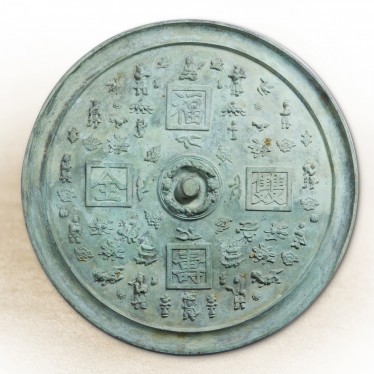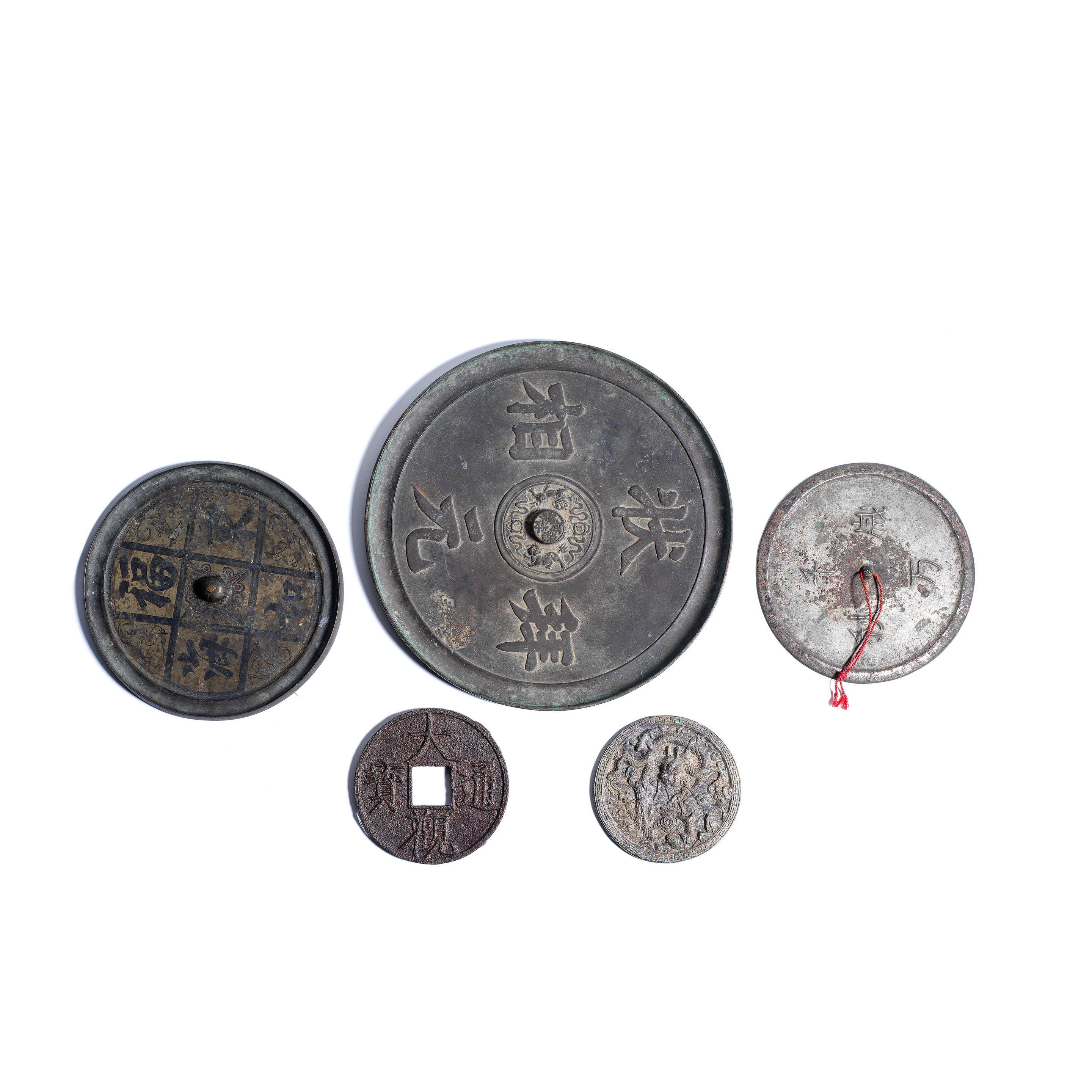Lot details Please note this Lot is to be sold at No Reserve. 本拍品不設底價 Inscription: ‘Yelian tonghua qing er ming, yi zhi weijing, yi wenzhang, changsheng yishou qu buxiang, yutian changjiu er riguang, qianwan sui xi leweiyang’ (The bronze mirror we made is clear and shiny. With such a mirror, you will be blessed with a long life, and it will ward off bad luck. We wish you a long life as long as heaven and earth, and eternal joy and happiness). Expert’s note: Inscribed bronze mirrors with bullet proof provenance, such and extensive and detailed inscription, and in such excellent condition overall, must be considered as exceedingly rare. The central knop rising from quatrefoil lotus petals, encircled by an eight-pointed star, surrounded by ancient cult symbols and decorated with an outer band holding the 37-character inscription in high relief, all within a sawtooth border on the rim. The circular bronze with a rich, naturally grown patina with malachite and cuprite encrustations. Provenance: Galerie Themis, Brussels, April 23, 1952 (according to an ancient family ledger inspected by Cabinet Portier, Paris, France, during their appraisal of the complete de Strycker estate; this ledger remains in the possession of the de Strycker family and may not be copied). Collection of Robert and Isabelle de Strycker, acquired from the above and thence by descent in the same family. The obverse with two old labels, one reading ‘MBR no. 174 Epoque Han. 20630. Chine,’ and the accompanying display stand with two inscriptions on the reverse. Robert de Strycker (1903-1968) was a French engineer who specialized in metallurgy. He was a Stanford graduate, a professor at the University of Leuven, a director of the Institute of Metallurgy at the Université Catholique de Louvain, and one of the most influential members of the faculty of applied sciences. After World War II, he made large contributions to France’s post-war recovery. Robert and his wife Isabelle (1915-2010) first encountered Chinese art at the British Museum during a stay in London in the 1930s. Enamored with the style and beauty, they both decided to study and collect Chinese works of art. In 1938 they eventually began to build their collection, buying from Belgian, Parisian, and English dealers. They kept close contact with the famous English collector Sir Harry Garner (1891-1977) and noted Czech collector and expert Fritz Low-Beer (1906-1976). In 1964, the couple lent 174 objects from their collection to the Belgian city of Leuven’s museum for an exhibition titled Oude kunst in Leuvens Privébezit (‘Old Art in Private Collections in Leuven’), and in 1967, they lent around thirty Japanese objects to the Royal Museums of Art and History in Brussels for their exhibition Kunst van Japan im belgischen Privatverzameingen (‘Japanese Art in Belgian Private Collections’). Condition: Superb condition with only minor old wear and some weathering, encrustations, scratches to the rim, and nicks, all exactly as expected from an ancient bronze mirror. Magnificent, naturally grown patina with fine cuprite and malachite encrustations. Weight: 875.2 (excl. stand) Dimensions: Diameter 18.4 cm Please click here to read the full description With a fitted wooden display stand wrapped in fabric, dating to around 1952. (2) Literature comparison: Compare a closely related bronze mirror, 14 cm diameter, dated to 2nd-1st century BC, in the National Museum of Asian Art, Smithsonian Institution, accession number S 2012.9.1756. Compare a related bronze mirror, 13 cm diameter, dated 2nd-1st century BC, in the National Museum of Asian Art, Smithsonian Institution, accession number 2012.9.2103. Compare a closely related bronze mirror, 18.8 cm diameter, dated to the Han dynasty, in the British Museum, registration number 1957,1119.1. Auction result comparison: Type: Closely related Auction: Christie’s New York, 20 March 2015, lot 718 Price: USD 16,250 or approx. EUR 19,500 converted and adjusted for inflation at the tim
Lot details Please note this Lot is to be sold at No Reserve. 本拍品不設底價 Inscription: ‘Yelian tonghua qing er ming, yi zhi weijing, yi wenzhang, changsheng yishou qu buxiang, yutian changjiu er riguang, qianwan sui xi leweiyang’ (The bronze mirror we made is clear and shiny. With such a mirror, you will be blessed with a long life, and it will ward off bad luck. We wish you a long life as long as heaven and earth, and eternal joy and happiness). Expert’s note: Inscribed bronze mirrors with bullet proof provenance, such and extensive and detailed inscription, and in such excellent condition overall, must be considered as exceedingly rare. The central knop rising from quatrefoil lotus petals, encircled by an eight-pointed star, surrounded by ancient cult symbols and decorated with an outer band holding the 37-character inscription in high relief, all within a sawtooth border on the rim. The circular bronze with a rich, naturally grown patina with malachite and cuprite encrustations. Provenance: Galerie Themis, Brussels, April 23, 1952 (according to an ancient family ledger inspected by Cabinet Portier, Paris, France, during their appraisal of the complete de Strycker estate; this ledger remains in the possession of the de Strycker family and may not be copied). Collection of Robert and Isabelle de Strycker, acquired from the above and thence by descent in the same family. The obverse with two old labels, one reading ‘MBR no. 174 Epoque Han. 20630. Chine,’ and the accompanying display stand with two inscriptions on the reverse. Robert de Strycker (1903-1968) was a French engineer who specialized in metallurgy. He was a Stanford graduate, a professor at the University of Leuven, a director of the Institute of Metallurgy at the Université Catholique de Louvain, and one of the most influential members of the faculty of applied sciences. After World War II, he made large contributions to France’s post-war recovery. Robert and his wife Isabelle (1915-2010) first encountered Chinese art at the British Museum during a stay in London in the 1930s. Enamored with the style and beauty, they both decided to study and collect Chinese works of art. In 1938 they eventually began to build their collection, buying from Belgian, Parisian, and English dealers. They kept close contact with the famous English collector Sir Harry Garner (1891-1977) and noted Czech collector and expert Fritz Low-Beer (1906-1976). In 1964, the couple lent 174 objects from their collection to the Belgian city of Leuven’s museum for an exhibition titled Oude kunst in Leuvens Privébezit (‘Old Art in Private Collections in Leuven’), and in 1967, they lent around thirty Japanese objects to the Royal Museums of Art and History in Brussels for their exhibition Kunst van Japan im belgischen Privatverzameingen (‘Japanese Art in Belgian Private Collections’). Condition: Superb condition with only minor old wear and some weathering, encrustations, scratches to the rim, and nicks, all exactly as expected from an ancient bronze mirror. Magnificent, naturally grown patina with fine cuprite and malachite encrustations. Weight: 875.2 (excl. stand) Dimensions: Diameter 18.4 cm Please click here to read the full description With a fitted wooden display stand wrapped in fabric, dating to around 1952. (2) Literature comparison: Compare a closely related bronze mirror, 14 cm diameter, dated to 2nd-1st century BC, in the National Museum of Asian Art, Smithsonian Institution, accession number S 2012.9.1756. Compare a related bronze mirror, 13 cm diameter, dated 2nd-1st century BC, in the National Museum of Asian Art, Smithsonian Institution, accession number 2012.9.2103. Compare a closely related bronze mirror, 18.8 cm diameter, dated to the Han dynasty, in the British Museum, registration number 1957,1119.1. Auction result comparison: Type: Closely related Auction: Christie’s New York, 20 March 2015, lot 718 Price: USD 16,250 or approx. EUR 19,500 converted and adjusted for inflation at the tim





.jpg)







Testen Sie LotSearch und seine Premium-Features 7 Tage - ohne Kosten!
Lassen Sie sich automatisch über neue Objekte in kommenden Auktionen benachrichtigen.
Suchauftrag anlegen